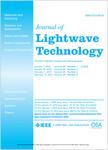版权所有:内蒙古大学图书馆 技术提供:维普资讯• 智图
内蒙古自治区呼和浩特市赛罕区大学西街235号 邮编: 010021

作者机构:Huawei Munich Res Ctr Opt & Quantum Commun Lab D-80992 Munich Germany Tech Univ Munich Chair Elect Design Automat D-80333 Munich Germany
出 版 物:《JOURNAL OF LIGHTWAVE TECHNOLOGY》 (J Lightwave Technol)
年 卷 期:2023年第41卷第12期
页 面:3783-3790页
核心收录:
学科分类:0810[工学-信息与通信工程] 0808[工学-电气工程] 08[工学] 0702[理学-物理学]
主 题:Chromatic dispersion mitigation digital signal processing intensity modulation direct detection neural network equalizer
摘 要:In this article, we discuss challenges and options for scaling IM/DD transceivers towards 800 Gbps. Our focus is CWDM4 PAM4 transmission and our target distance is 10 km in O-band, which is a most urgent use case for next generation optical short reach systems like data centre interconnects and networks. At this reach and rate, chromatic dispersion (CD) becomes the main challenge. Its mitigation is essential and primarily done with digital signal processing. State of the art techniques, however, make transceivers quickly too complex. We show upon measurement results how neural network equalization can meet Volterra equalization performance with 30% less hardware multiplier complexity. When also applying magnitude weight pruning, an additional 43% reduction is possible without performance loss across all CWDM4 lanes. If needed, an added MLSE stage can further push performance in both cases. In any of these configurations, a key enabler against strong CD penalties is duobinary training, which is applicable to all feed-forward equalization architectures.